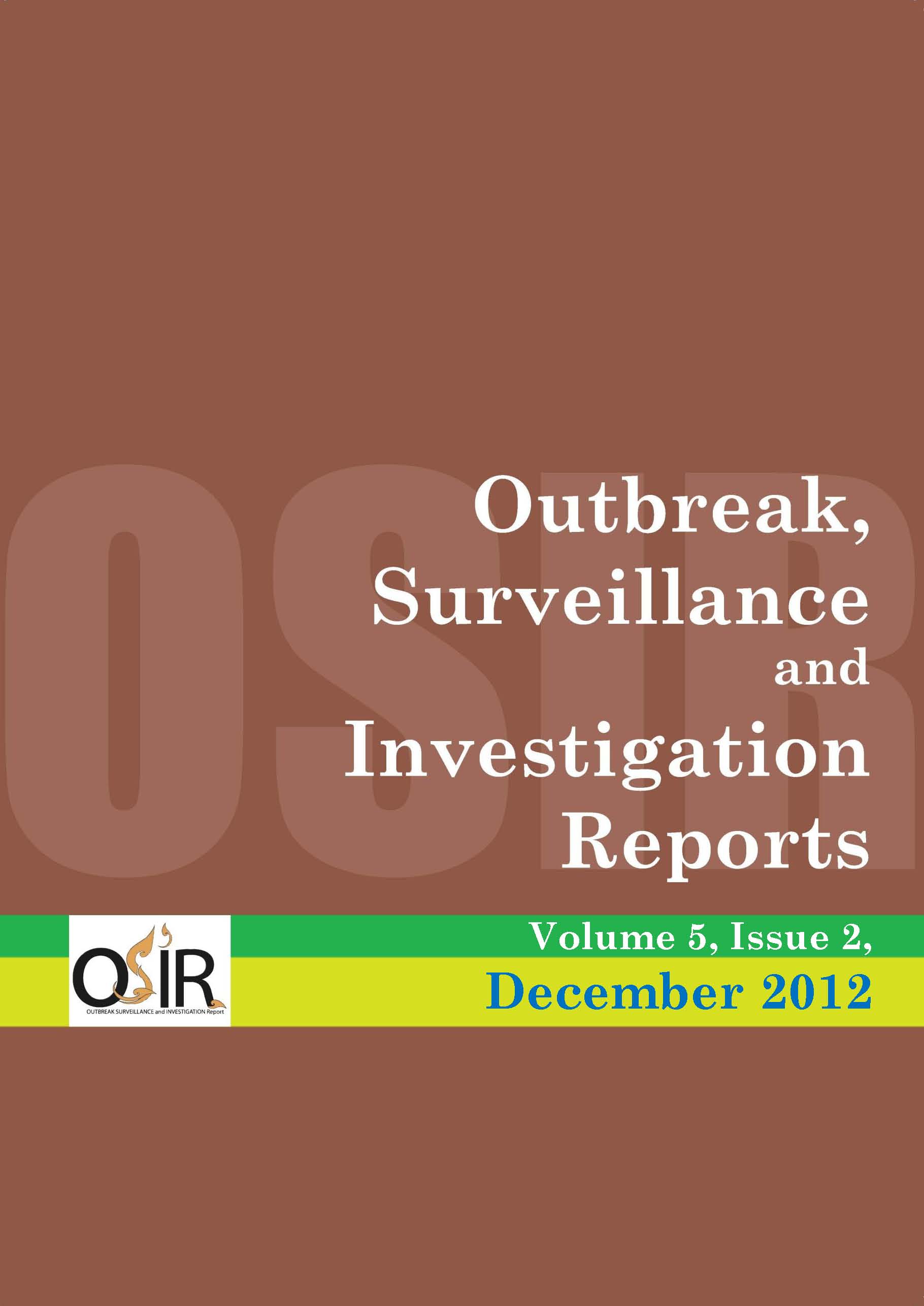Bacillus cereus Food Poisoning Outbreak in a Kindergarten School, Bangkok, Thailand, December 2009
DOI:
https://doi.org/10.59096/osir.v5i2.263348Keywords:
Bacillus cereus, food poisoning, school mealsAbstract
On 18 Dec 2009, the Bureau of Epidemiology was notified that 20 students from a private kindergarten school were treated for vomiting and diarrhea. An investigation was conducted to verify the diagnosis, identify source of the outbreak, and implement prevention and control measures. We conducted a descriptive and retrospective cohort study. Medical records at the hospital were reviewed. We also interviewed students, teachers and cooks at the school. A case was a student in this school who developed vomiting with at least one of the followings: fever, diarrhea or abdominal pain from 18 to 22 Dec 2009. Twenty three clinical specimens (vomitus and rectal swabs) and food samples were collected, and sent to National Institute of Health for bacterial culture. Logistic regression was used to determine the food items associated with illness. Symptoms included vomiting (100%), abdominal pain (59%), diarrhea (31%) and fever (26%). Bacillus cereus was isolated from three out of six vomitus specimens as well as the sweet stewed egg and pork served for school lunch on 18 Dec 2009. Thus, this outbreak was due to Bacillus cereus (emetic form) and the common source was likely to be the sweet stewed egg and pork (adjusted OR 2.1, 95% CI 1.0-4.4). To prevent similar outbreaks in the future, people involved in food preparation and serving should emphasize on personal hygiene and sanitary food handling practices. School administrators should exclude symptomatic cooks and food handlers from cooking.
References
World Health Organization. Food safety and foodborne illness. [cited 2012 Jun 1]. <http://www.who.int/mediacentre/factsheets/fs237/en/>
Thaikruea L, Pataraarechachai J, Savanpunyalert P, Naluponjiragul U. An unusual outbreak of food poisoning. Southeast Asian J Trop Med Public Health. 1995 Mar;26(1):78-85.
Thailand. Bureau of Epidemiology. Department of Disease Control. Ministry of Public Health. Food poisoning in 2008. [cited 2012 Jun 1]. <http://www.boe.moph.go.th/boedb/surdata/disease.php?dcontent=old&ds=03>
Stenfors Arnesen LP, Fagerlund A, Granum PE. From soil to gut: Bacillus cereus and its food poisoning toxins. FEMS Microbiol Rev. 2008 Jul;32(4):579-606. Epub 2008 Apr 15. [cited 2010 Dec 1]. <http://www.ncbi.nlm.nih.gov/pubmed/18422617>
US Food and Drug Administration. Bad bug book: Bacillus cereus and other Bacillus spp. [cited 2012 Jun 11]. <http://www.fda.gov/food/foodsafety/foodborneillness/Foodborneillnessfoodbornepathogensnaturaltoxins/badbugbook/ucm070492.htm>
Centers for Disease Control and Prevention. Guide to confirming a diagnosis in foodborne disease. [cited 2012 Jun 11]. <http://www.cdc.gov/outbreaknet/references_resources/guide_confirming_diagnosis.html>
US Department of Health, Education and Welfare, National Communicable Disease Center, Atlanta, Georgia. Foodborne outbreaks. MMWR annual summary. 1968:32.
Midura T, Gerber M, Wood R, Leonard AR. Outbreak of food poisoning caused by Bacillus cereus. Public Health Rep. 1970 January;85(1): 45-48.
Thailand. Bureau of Epidemiology. Department of Disease Control. Ministry of Public Health. Food poisoning in 2009. [cited 2010 Oct 15]. <http://www.boe.moph.go.th/boedb/surdata/disease.php?ds=03>
Beuchat LR, Ryu JH. Produce handling and processing practices. Emerg Infect Dis. 1997 Oct-Dec; 3(4): 459-465. [cited 2010 Oct 30]. <http://www.cdc.gov/ncidod/EID/vol3no4/beuchat.htm>
Taylor AJ, Gilbert RJ. Bacillus cereus food poisoning: a provisional serotyping scheme. [cited 2010 Nov 5]. <http://jmm.sgmjournals.org/cgi/reprint/8/4/543.pdf>
Downloads
Published
How to Cite
Issue
Section
License
Copyright (c) 2023 Outbreak, Surveillance, Investigation & Response (OSIR) Journal

This work is licensed under a Creative Commons Attribution-NonCommercial-NoDerivatives 4.0 International License.









